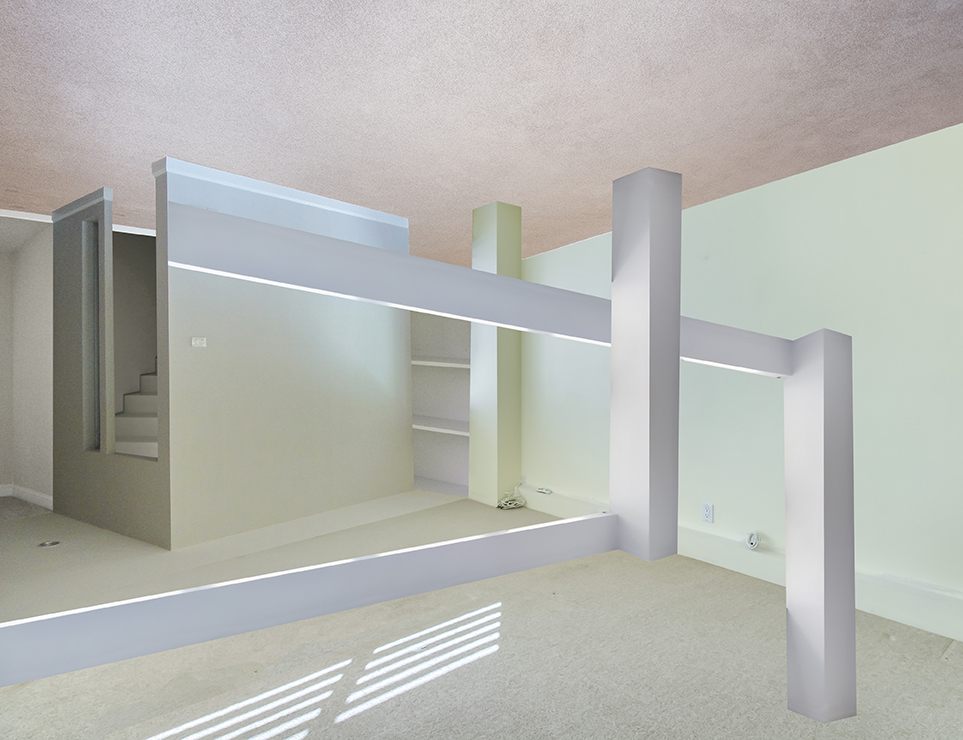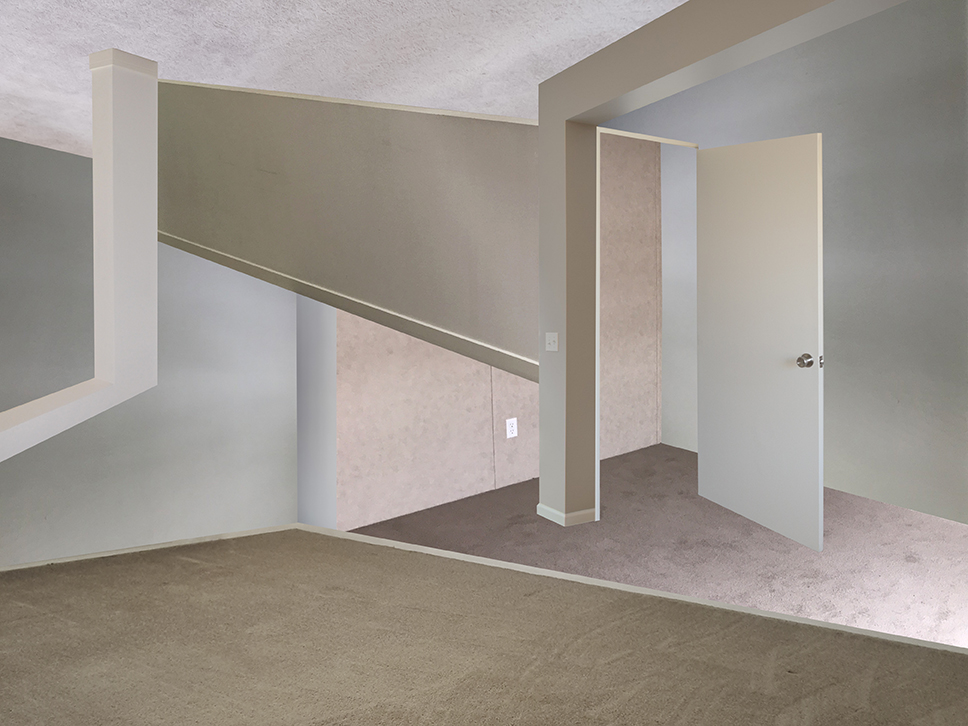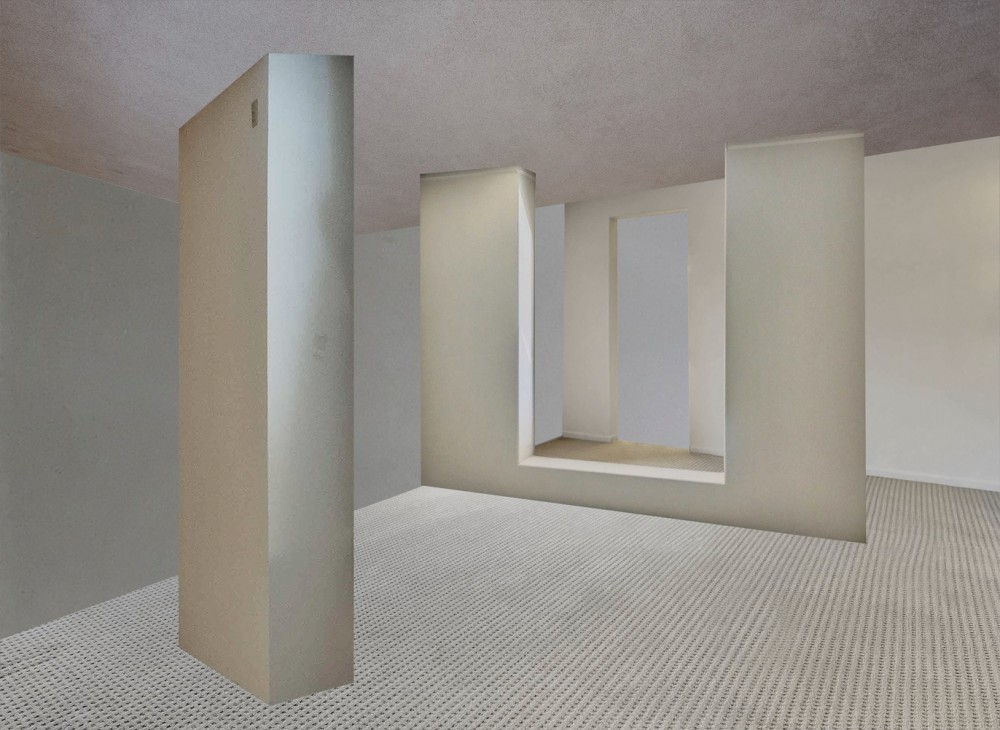Real Estate Collages by the artist Camiel Duytschaever and the Strangeness of the American Interior
Svizzera 240: House Tour, the Golden Lion-winning Swiss Pavilion installation at the 2018 Venice Architecture Biennale, presented the standard-issue fittings that define impersonal Swiss rentals but shrank and expanded them in rooms that defy human scale. Curated by Alessandro Bosshard, Li Tavor, Matthew van der Ploeg, and Ani Vihervaara, House Tour estranged the severe banality of the mass-market home and pushed to the fore what so often fades into the background. Artist Camiel Duytschaever, a 24-year-old Texas-native, also currencies in the profoundly boring to a similarly disorienting effect. Her mischievous digital collages are created by mining the depths of the Internet’s eidetic mind to find empty real-estate shots which she then deconstructs and in turn reconstructs, highlighting the very strangeness already present in the uncanny American interior.

Camiel Duytschaever, The Playroom (2018).
Though Duytschaever chooses images without respect to geography, it is perhaps fitting she was born in Houston, a metroplex that is defined by its vast urban-suburbanism which was permitted and even tacitly encouraged by a peculiar lack of zoning laws. Improbable neighborhood agglomerations of single-family homes, strip malls, and minor high rises exist side by side. Houston is also an ideal site in which to look for real-estate imagery because of its dynamic property market, which in the summer of 2018 hit record sales volumes. Many residents seek out distinctly indistinct McMansions, “post-Fordist homes” that Duytschaever says would cause “Laugier to have an absolute fit” — a reference to the 18th-century French architectural theorist who criticized the Italian Renaissance for what he perceived as its many Classical errors.
Duytschaever describes her own experience of being indoors as a being trapped in “a series of containers within containers.” The environments she built for PIN–UP as part of her series Rooms I Want To self-contain to excess. They’re virtual interiors that vehemently deny any outside; though they use the language of architecture and the visual tools of classical perspective, they resist any coherent spatial reading. The rooms remain physically unoccupiable as much as they, in their eerie emptiness, occupy our own psyches. In their superficiality and mostly online existence, they resist any architectural sensation, instead creating “virtual worlds that are ships in a bottle,” as impenetrable as the images of walls that comprise them.

Camiel Duytschaever, Proscenium (2018).
Duytschaever entirely relies on real-estate photography found on Google Images, which, according to the artist, has revealed itself as “extremely finite.” Only so many images appear, and many adjacent searches end up returning the same images. If you’re running these searches compulsively, as she does, you quickly reach Google’s limit. One day, however, she accidentally stumbled on a particularly helpful method in tricking Google. Duytschaever was looking up congressional bills, which have numbers like H.R.3051 (a 2017 bill on student loans), when, curious as to how a bill might be represented visually in the mind of the Internet, she clicked on Google’s “Images” tab. Surprisingly, homes showed up. In some ways, this is perhaps obvious since we organize real estate primarily around numbers — addresses, square feet, mortgage costs, etc.. She began adding numbers — some of significance, others random — and found a plethora of supplementary home options, the schizophrenic associations of disparate metadata unmasked in visual form.
While Duytschaever is undeniably fascinated with space and architecture, Rooms I Want To also unpacks what she calls “big pictures,” big data’s visual offshoots. When she was first looking at the images “of” congressional bills, she was interested to know what exactly it was that people, algorithms, artificial intelligence, and chance attached to that bill, and what aspects of that query’s tag were seemingly unrelated to the bill but circled in its dataspace. From this, she sought to render these incomprehensible, opaque networks of meaning readable, if still not comprehensible. What these collaged homes reveal is not only the ways we visualize and sell architecture but the otherwise invisible overlapping ways we organize and represent our technical and domestic world. The secret associative network that organizes our Internet images is here unearthed to be seen. In reconstructing these empty homes, the phenomenological distinctions of experiencing space and experiencing data are entirely elided.

Camiel Duytschaever, Enter (2018).
In the end, says Duytschaever, “real-estate images are not about space or architecture at all. They’re just signs.” They act to cue people into certain traits — wood flooring, crown molding, bay windows, features that even when materialized IRL are often just weak, imagistic signifiers of wealth or taste. Real-estate photos, and in many ways real homes themselves, aren’t spatial representations. They’re advertising. And, as is the case with advertising, trends change. This has become a problem for Duytschaever, since the once-popular method of showing empty homes has given way to interiors staged with neutral, inoffensively aspirational furniture, and now even virtual home staging.
The real-estate website’s visual Zeitgeist reveals “our collective desire to have a ‘prototype’ image for a home,” a pure home-ness that does not and cannot exist. Duytschaever’s images are at once terrifying and erotic. Made from and for the Internet, their spatial significance is that they cannot be spatial at all — like walls and screens, they possess a “defining surfaceness.” A psychoanalysis of the Internet’s mind, the collages of Rooms I Want To figure a regression to pure suburban desire, impossible rooms forever waiting to be filled.
Text by Drew Zeiba.
All images courtesy Camiel Duytschaever.
Taken from PIN–UP 25 Fall Winter 2018/19.
